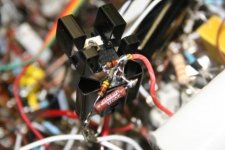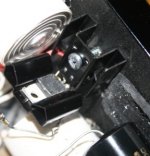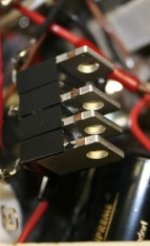A CCS does two main things -- 1) it forces a tube to operate in its most linear range and 2) it controls the signal current loops keeping unwanted components out of the signal loop path. My experience says that "tubey" sound has little to do with how tubes sound, but instead has a lot to do with how other components, mostly capacitors, alter the signal. The difference in sound between tube and solid state has more to do with the different topologies used than the devices themselves. If you want mushy tube bloat, don't use a CCS.
Two things to read:
PimmLabs
ETF Presentation
Two things to read:
PimmLabs
ETF Presentation
I replaced the plate resistors on the 2C22 output tubes of my Supratek Chenin tube preamp with a cascoded IXYS10M45S CCS, with SiC Schottky diode bias on the cathodes and the difference was astonishing, and completely for the better to my ears. Images just seem to pop out of the soundstage, WAY more 3-D than with just the resistor.
I'm using 1/4W 1K Allen Bradley CC gate stopper resistors, and Mills MRA-5 set resistors, with slip-on heat sinks over the CCS chips (see photo).
I'm using 1/4W 1K Allen Bradley CC gate stopper resistors, and Mills MRA-5 set resistors, with slip-on heat sinks over the CCS chips (see photo).
Attachments
My $0.02
I did a lot of work with CCS bits back in the 80's, both SS and VT. I eventually went back to biasing/loading tube stages the old-fashioned way... with one exception. I do like a highly-accurate CCS for a long-tail pair phase inverter but that's it. It was an expensive option but it provided exceptional linearity for the phase inverter.
Regards, KM
I did a lot of work with CCS bits back in the 80's, both SS and VT. I eventually went back to biasing/loading tube stages the old-fashioned way... with one exception. I do like a highly-accurate CCS for a long-tail pair phase inverter but that's it. It was an expensive option but it provided exceptional linearity for the phase inverter.
Regards, KM
A CCS does two main things -- 1) it forces a tube to operate in its most linear range and 2) it controls the signal current loops keeping unwanted components out of the signal loop path. My experience says that "tubey" sound has little to do with how tubes sound, but instead has a lot to do with how other components, mostly capacitors, alter the signal. The difference in sound between tube and solid state has more to do with the different topologies used than the devices themselves. If you want mushy tube bloat, don't use a CCS.]
Thank you the links. I have read Gary's site before and often. Not looking for bloated sound, just do not want a SS/sterile sound either. I am going to give it a try when I get the amp chassis breadboarded to see what it sounds like to me.
I replaced the plate resistors on the 2C22 output tubes of my Supratek Chenin tube preamp with a cascoded IXYS10M45S CCS, with SiC Schottky diode bias on the cathodes and the difference was astonishing, and completely for the better to my ears. Images just seem to pop out of the soundstage, WAY more 3-D than with just the resistor.
I'm using 1/4W 1K Allen Bradley CC gate stopper resistors, and Mills MRA-5 set resistors, with slip-on heat sinks over the CCS chips (see photo).
Thanks Magz. I will give it a serious listen shortly.
I modified my 300B mono's with 2 stages 6BX7 as driver. The 6BX7's are with 10M45 CCS plate load, bypassed cathode resistor, and capacitor coupling. Both 6BX7's are running at 12mA.
The 300B sounds really good now. Very smooth mids, clear and sharp highs, and defined bass.
With resistor plate load, it is more rich in 2nd harmonics. Most people would like this kind of sound. I just try to experience the kind of sound with less distortion.
Johnny
Funny you mention this. The 6BX7 is where I really noticed the difference between resistor and CCS loading. And it measured also as a huge difference in 2nd harmonic distortion. There was actually a fair amount of 2nd harmonic distortion even *with* the CCS at 12mA. And I did try a couple of different 6BX7s. I think one was .3something and another .45% when driving about 60V P-P output. I think the resistor was about 12K and over 1% distortion.
In the overall amp there was some distortion cancellation between the 6BX7 driver and the 6BX7 output stage with
I like it when the measurements explain the differences heard.
Cheers
Michael
It is diffcult to describe the effect. It is similar to a bleaching of the sound. If it were a picture, some of the color has been removed, making it paler than it sound be.
I do find that "color" = distortion, and adding a CCS is a sure-fire way to reduce distortion! It really allows a triode do its best work. If concerned you can always use a tube CCS
On the topic of distortion, I have two lower-end systems set up presently - a vintage pentode amp driving high efficiency EV 3-way speakers, and another vintage pentode amp driving modern lower-efficiency MTMs with Eton drivers. The system with EVs is far more "colorful", but grows tiring after a few afternoons of listening. Then I switch back to the other system which has quite low 2nd HD, but still some 3rd HD, until it starts to get to me. It's always a relief to switch back to the other, regardless which the "other" is. With higher-end systems that have measurably lower distortion, I never even consider swapping gear!
[
I use the photography analogy as a means to explain what I hear. The color balance is real life. Kodachrome is an example of "colored" but pleasant. Cibachrome is what I would term as neutral and pleasing. If I used a black and white analogy, it would be the 19% gray scale as neutral. Color is easier for most people to understand the analogy. It may well be that I prefer some amount of 2nd order, but it sure sounds closer to real instruments than the so called "accuracy" that many people tout, if that is what I am hearing in my system.
I will try the CSS in this new amplifier to see what I think of it. Still considering which of the many examples that people like to give a first shot to right now. I have never had a good listening experiences with circuits that mixed SS with tubes. I hope that this time I find a different result. It would be nice to find something that truly pushed my listening experience to another level.
I use the photography analogy as a means to explain what I hear. The color balance is real life. Kodachrome is an example of "colored" but pleasant. Cibachrome is what I would term as neutral and pleasing. If I used a black and white analogy, it would be the 19% gray scale as neutral. Color is easier for most people to understand the analogy. It may well be that I prefer some amount of 2nd order, but it sure sounds closer to real instruments than the so called "accuracy" that many people tout, if that is what I am hearing in my system.
I will try the CSS in this new amplifier to see what I think of it. Still considering which of the many examples that people like to give a first shot to right now. I have never had a good listening experiences with circuits that mixed SS with tubes. I hope that this time I find a different result. It would be nice to find something that truly pushed my listening experience to another level.
Last edited:
It may well be that I prefer some amount of 2nd order, but it sure sounds closer to real instruments than the so called "accuracy" that many people tout, if that is what I am hearing in my system.
Oh it probably is - real instruments are louder than typical music reproduced in a home, so they induce more distortion in your ears than music on a hifi would. Amplifiers and speakers adding a bit more even-order HD will thus sound louder, and closer to reality, at a more home-friendly volume level. Hence, low distortion systems are prone to sound like a miniature version of reality, and apparently "quieter" at the same output level. At least, this is why I believe people think that SE amps seem louder and "more powerful" than their power ratings suggest - they just trick the ear quite effectively. Everyone's ears are different though - perhaps those with ears producing less distortion at high volume will prefer a lower distortion system, as they have less need for added coloration to trigger sensation of loudness and realism.
What do you all feel is the sonic impact on the sound of tubed systems using SS CSS's? Is there any negative impact to the musicality of the tubed circuits when SS components are added to your ears? I have heard from many that have tried it that it adds a layer of dryness to the sound, but never attempted to try it myself yet. Are they reliable from an electrical stand point? Nothing is ever perfect in my experience, so I am curious what the benefits/tradeoffs are with regards to the overall sound quality.
I found with a ccs on the frontend I didnt get as much distortion as I did from a none ccs.
Using an SRPP front end also lowers the output impedance.
Has anyone tried hybrid CCS with a tube as the current delivering device next to the circuit ? I believe Allen wright was in favour of this etc, but I have not found a lot of reports from people who tried both: SS-CCS vs Tube/Hybrids-CCS...found only this article: CCS Circuits | Tubelab where swep tunes are recommended, but no word about how they sound vs. SS....
I've built at least a dozen amps/preamps/phono stages with resistive loads at first, then converted to current sources. After a dozen, I just always use a CCS.
If you need the resistive plate load, just send some extra current through the CCS and connect your resistor from plate to ground
If you need the resistive plate load, just send some extra current through the CCS and connect your resistor from plate to ground
I have downloaded gary's articles and pcb and order them from a pcb-service...has anyone any experience with the setup-values of the penthodes ? How much voltage do they need on top of what the amp needs ? I believe he planned with an El34, El84 or 6au6...but did only specify bias grid voltage ranges, not how much drop out voltage to expect...
Has anyone had a sonical impression of the hybrid-CCS vs. SS ?
Has anyone had a sonical impression of the hybrid-CCS vs. SS ?
- Status
- This old topic is closed. If you want to reopen this topic, contact a moderator using the "Report Post" button.
- Home
- Amplifiers
- Tubes / Valves
- What is the sonic impact of SS CCS in tube equipment



